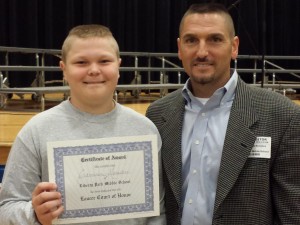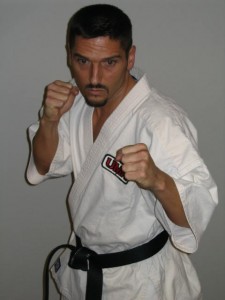At Liberty Park today, Colter Bean talked about what it was like to compete at the highest level in the MLB. Later in his presentation, Bean congratulated ESP athlete Cameron Monistere for being chosen as one of Liberty Park’s Lancer Court of Honor students.
Four students from each grade are chosen as leaders in their school, not just scholastic leadership, but also for possessing the will and determination to choose to do the right thing, regardless of whether the teaching staff is watching or not. These are some of the attributes that Bean mentioned as absolutely necessary to have in order to compete in the NCAA and the MLB. Bean is also a product of the Vestavia School system.
Bean attended Vestavia Hills High School in Birmingham before attending Auburn University. Bean played in the College World Series and was named All-SEC second team in 2000. Bean still holds the Auburn team record with 108 games pitched and 106 games relieved in his NCAA career.
Following his college graduation, the Yankees signed Bean as an undrafted free agent on May 31, 2000. At this point he stressed to the kids that was not a “good thing”: “This means I wasn’t drafted by anyone, I wasn’t a prospect. I was a suspect,” said Bean as he addressed the student body as well as the proud parents in the crowd.
“I played 25 days in the Big League, and I can say that the mental toughness that you need in order to compete at that level is taught here, by your teachers and by your parents.” Bean had the attention of the entire student body, but maybe none as much as Cameron Monistere’s. Cameron has been coached by the best at ESP and has worked with numerous MLB players, but today Bean  would shake his hand not because of his success on the diamond, but for his success as a leader among students at Liberty Park.
would shake his hand not because of his success on the diamond, but for his success as a leader among students at Liberty Park.
Needless to say, his dad was proud! Coach Monistere, one of the founders of ESP, has tried to teach this kind of leadership on and off the field to not only his own boys, but to many of the boys that train under him. In addition, we here at ESP do not believe it mere coincidence that one of the other boys to be recognized was Jonathan Hand, one of Cameron’s teammates on the Vestavia Developmental League and also on the Birmingham White Sox.

 Let’s start with glutamine. This is one of the most available amino acids in protein, and the body uses it for muscle repair and helps speed recovery. This is an amino that I like to take at night before I go to bed. Some people have issues with taking any supplement at night, but I have never had this issue. I like the chewable type or the ones that you can mix in a glass of water. I also believe, but have no solid research to prove this, that glutamine helps keep the immune system in check. It doesn’t help if you are already sick, (look to zinc if that is your issue) but it seems to keep the body’s immune system working normally even when dieting or training hard.
Let’s start with glutamine. This is one of the most available amino acids in protein, and the body uses it for muscle repair and helps speed recovery. This is an amino that I like to take at night before I go to bed. Some people have issues with taking any supplement at night, but I have never had this issue. I like the chewable type or the ones that you can mix in a glass of water. I also believe, but have no solid research to prove this, that glutamine helps keep the immune system in check. It doesn’t help if you are already sick, (look to zinc if that is your issue) but it seems to keep the body’s immune system working normally even when dieting or training hard.


